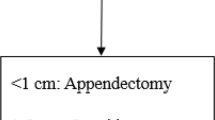Abstract
Background
Appendiceal neuroendocrine tumors (aNET) are a common entity in routine medical care, with a rate per appendectomy as high as 0.3–0.9 %. Considering the relatively young age at diagnosis for these patients, exact information about the long-term prognosis of aNET is required. Survival rates vary substantially between 71 and 100 % and are mostly limited to 5 years. This investigation assessed the long-term mortality rates of patients who underwent aNET resections at fifteen hospitals.
Methods
Between 1990 and 2003, the 10-year survival rates of 79 patients were analyzed using risk-adjusted Cox proportional hazard regression models adjusted for population-based baseline mortality. Additionally, prognostic factors for the oncologic outcomes were assessed.
Results
The median follow-up of all patients was 12.1 and 13.7 years for those alive. All patients underwent curative R0 resections. No distant metastases were diagnosed. A total of 31 (39.2 %), 29 (36.7 %), 18 (22.8 %), and 1 (1.3 %) patients had stage I, IIA, IIB, and IIIB aNET, respectively, according to the latest classification by the European Neuroendocrine Tumor Society. The 10-year overall and relative survival rates were 83.6 % (95 % CI 75.5–92.6 %) and 96.7 % (95 % CI 87.5–107 %), respectively. The 10-year relative survival rate after resection of aNET did not differ from the survival of the average national population with the same age and gender (p = 0.947). Second primary malignancies (hazard ratio of death 7.0, 95 % CI 1.6–30.6) were identified as a significant prognosticator for long-term survival.
Conclusions
Long-term survival is not significantly depreciated after the curative resection of aNET.

Similar content being viewed by others
References
Hauso O, Gustafsson BI, Kidd M et al (2008) Neuroendocrine tumor epidemiology: contrasting Norway and North America. Cancer 113:2655–2664
Maggard MA, O’Connell JB, Ko CY (2004) Updated population-based review of carcinoid tumors. Ann Surg 240:117–122
Modlin IM, Lye KD, Kidd M (2003) A 5-decade analysis of 13,715 carcinoid tumors. Cancer 97:934–959
Addiss DG, Shaffer N, Fowler BS et al (1990) The epidemiology of appendicitis and appendectomy in the United States. Am J Epidemiol 132:910–925
Anderson JE, Bickler SW, Chang DC et al (2012) Examining a common disease with unknown etiology: trends in epidemiology and surgical management of appendicitis in California, 1995–2009. World J Surg 36:2787–2794. doi:10.1007/s00268-012-1749-z
Shapiro R, Eldar S, Sadot E et al (2011) Appendiceal carcinoid at a large tertiary center: pathologic findings and long-term follow-up evaluation. Am J Surg 201:805–808
In’t Hof KH, van der Wal HC, Kazemier G et al (2008) Carcinoid tumour of the appendix: an analysis of 1485 consecutive emergency appendectomies. J Gastrointest Surg 12:1436–1438
Rorstad O (2005) Prognostic indicators for carcinoid neuroendocrine tumors of the gastrointestinal tract. J Surg Oncol 89:151–160
Robinson D, Sankila R, Hakulinen T et al (2007) Interpreting international comparisons of cancer survival: the effects of incomplete registration and the presence of death certificate only cases on survival estimates. Eur J Cancer 43:909–913
Pape UF, Perren A, Niederle B et al (2012) ENETS consensus guidelines for the management of patients with neuroendocrine neoplasms from the jejuno-ileum and the appendix including goblet cell carcinomas. Neuroendocrinology 95:135–156
Bevölkerungsbewegung–Analysen–Jährliche Sterbetafeln, Bundesamt für Statistik, 2013. http://www.bfs.admin.ch/bfs/portal/de/index/themen/01/06/blank/dos/la_mortalite_en_suisse/tabl02.html. Accessed 18 Nov 2014
Pohar M, Stare J (2007) Making relative survival analysis relatively easy. Comput Biol Med 37:1741–1749
Ederer F, AXTELL LM, CUTLER SJ (1961) The relative survival rate: a statistical methodology. Natl Cancer Inst Monogr 6:101–121
Andersen PK, Borch-Johnsen K, Deckert T et al (1985) A Cox regression model for the relative mortality and its application to diabetes mellitus survival data. Biometrics 41:921–932
Danieli C, Remontet L, Bossard N et al (2012) Estimating net survival: the importance of allowing for informative censoring. Stat Med 31:775–786
Ishwaran H, Kogalur UB (2010) Consistency of random survival forests. Stat Probab Lett 80:1056–1064
Habal N, Sims C, Bilchik AJ (2000) Gastrointestinal carcinoid tumors and second primary malignancies. J Surg Oncol 75:310–316
Godwin JD (1975) Carcinoid tumors. An analysis of 2837 cases. Cancer 36:560–569
Moertel CG, Dockerty MB, Judd ES (1968) Carcinoid tumors of the vermiform appendix. Cancer 21:270–278
Sandor A, Modlin IM (1998) A retrospective analysis of 1570 appendiceal carcinoids. Am J Gastroenterol 93:422–428
McGory ML, Maggard MA, Kang H et al (2005) Malignancies of the appendix: beyond case series reports. Dis Colon Rectum 48:2264–2271
Grozinsky-Glasberg S, Alexandraki KI, Barak D et al (2013) Current size criteria for the management of neuroendocrine tumors of the appendix: are they valid? Clinical experience and review of the literature. Neuroendocrinology 98:31–37
Plockinger U, Couvelard A, Falconi M et al (2008) Consensus guidelines for the management of patients with digestive neuroendocrine tumours: well-differentiated tumour/carcinoma of the appendix and goblet cell carcinoma. Neuroendocrinology 87:20–30
Altman DG, Bland JM (1995) Absence of evidence is not evidence of absence. BMJ 311:485
Author information
Authors and Affiliations
Corresponding author
Ethics declarations
Conflict of interest
None.
Additional information
Thomas Steffen and Sabrina M. Ebinger have contributed equally.
Rights and permissions
About this article
Cite this article
Steffen, T., Ebinger, S.M., Warschkow, R. et al. Long-Term Survival is not Impaired After the Complete Resection of Neuroendocrine Tumors of the Appendix. World J Surg 39, 2670–2676 (2015). https://doi.org/10.1007/s00268-015-3164-8
Published:
Issue Date:
DOI: https://doi.org/10.1007/s00268-015-3164-8




